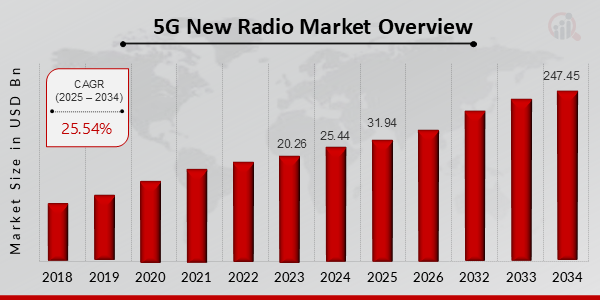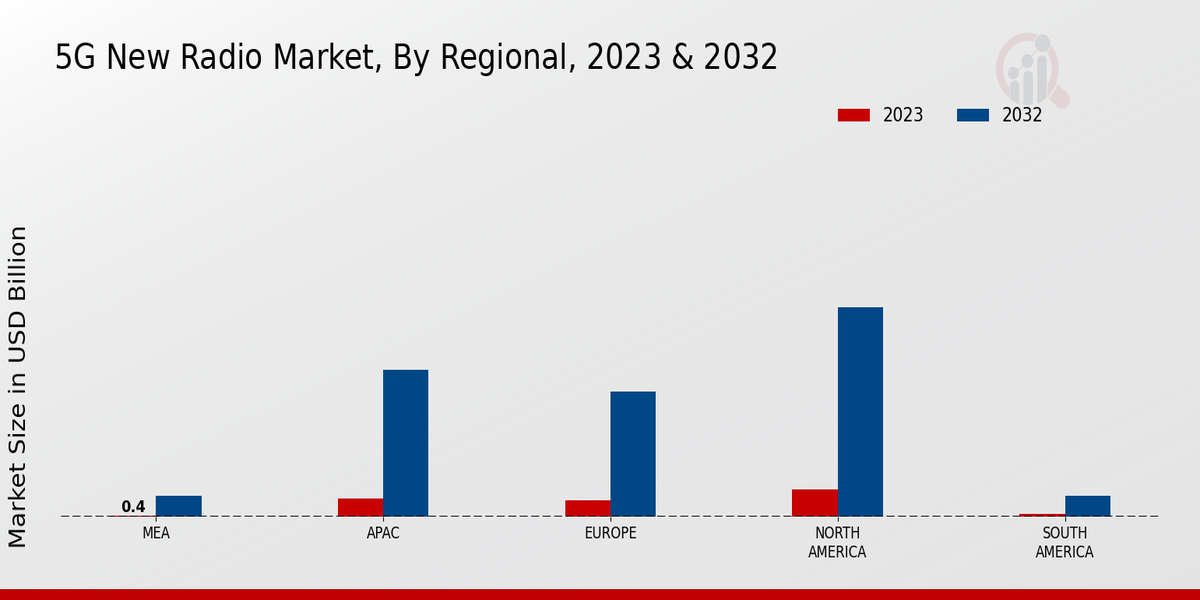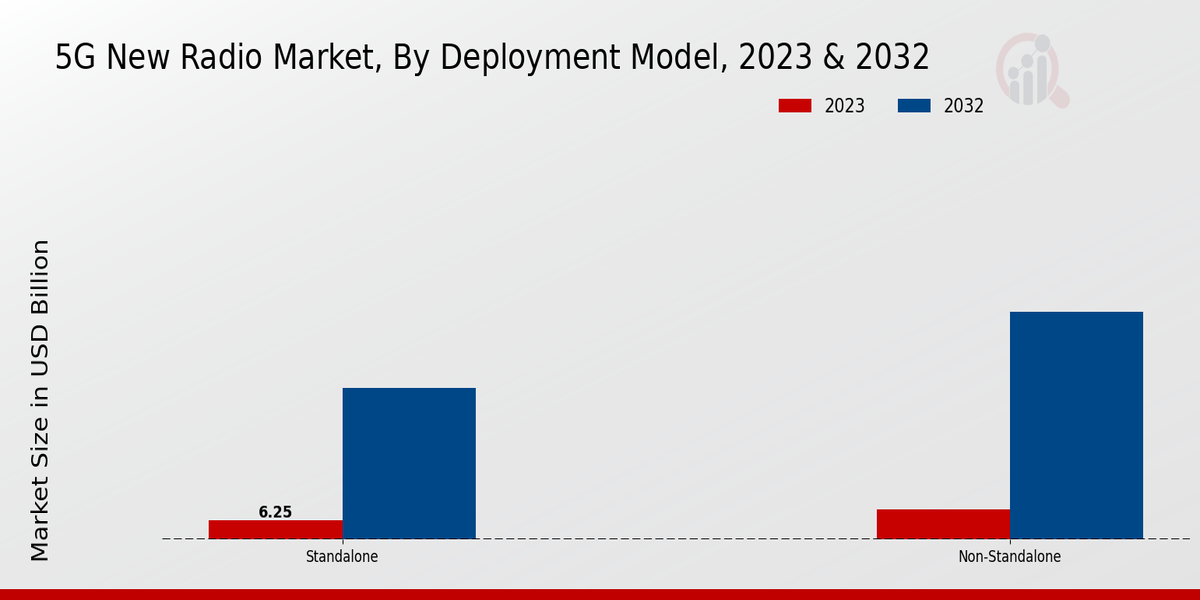5G New Radio Market Overview
5G New Radio Market is projected to grow from USD 31.94 Billion in 2025 to USD 247.45 Billion by 2034, exhibiting a compound annual growth rate (CAGR) of 25.54% during the forecast period (2025 - 2034). Additionally, the market size for 5G New Radio Market was valued at USD 25.44 billion in 2024
Key 5G New Radio Market Trends Highlighted
The 5G New Radio Market is experiencing significant growth, driven primarily by the increasing demand for high-speed internet and connectivity across various sectors. The proliferation of smart devices, IoT applications, and the need for high-bandwidth services are pushing telecommunications companies to invest in 5G infrastructure. This technology not only enhances data transfer rates but also reduces latency, enabling real-time communication and advanced applications such as augmented reality, virtual reality, and autonomous vehicles. The advent of Industry 4.0 is playing a pivotal role in accelerating the deployment of 5G networks, as industries seek to leverage this technology for improved efficiency and innovation.
Opportunities to be explored in the 5G New Radio Market are vast, particularly in developing regions where digital transformation is gaining momentum. As more businesses and consumers seek reliable, high-speed connectivity, the demand for robust 5G networks is expected to rise. This includes the potential for new revenue streams through innovative services and applications that cater to various industries. Moreover, governments and regulatory bodies are increasingly recognizing the importance of 5G and are implementing policies to facilitate its adoption, further enhancing market opportunities.
Trends in recent times indicate a rapid evolution in the 5G landscape, with various telecom players collaborating to optimize network deployment and enhance user experience. The shift towards virtualized and cloud-native network architectures is making 5G deployment more efficient and scalable. Additionally, advancements in technology, including the integration of artificial intelligence and machine learning in network management, are enabling better resource allocation and improved operational efficiency. As the global demand for connectivity continues to soar, the 5G New Radio Market is poised for transformative growth, driven by these factors.
Figure 1: 5G New Radio Market, 2025 - 2034

Source: Primary Research, Secondary Research, MRFR Database and Analyst Review
5G New Radio Market Drivers
Increasing Demand for High-Speed Connectivity
The growing demand for high-speed connectivity is a key driver fueling the growth of the 5G New Radio Market Industry. As digital transformation progresses across various sectors including telecommunications, IoT, transportation, and entertainment, the need for faster and more reliable internet connections has surged. Businesses and consumers alike require enhanced bandwidth to support advanced applications such as streaming services, virtual reality, and cloud computing. With the rise of smart cities and smart devices, the necessity for low latency and high throughput becomes paramount, further propelling the demand for 5G infrastructure. This shift is not just limited to urban areas but is expanding to rural regions as well, which drives network providers to invest heavily in 5G deployment. The continuous evolution of technology and the importance of digital engagement in daily life mean that high-speed connectivity is no longer a luxury but a necessity. As more sectors adapt to this new digital landscape, the 5G New Radio Market Industry is positioned to experience significant growth, with stakeholders investing in technology to meet the dynamic needs of consumers and industries.
Expansion of Internet of Things (IoT) Applications
The expansion of Internet of Things (IoT) applications is another significant driver in the 5G New Radio Market Industry. 5G technology offers a low latency and massive connectivity required to support a vast network of interconnected devices. As more industries embrace IoT solutions for automation, monitoring, and data collection, the demand for 5G networks is set to rise. Enhanced connectivity allows for real-time data exchange and improved operational efficiency across various sectors such as manufacturing, healthcare, and agriculture. The growing trend towards smart home devices, industrial IoT, and connected vehicles is further increasing the need for robust 5G infrastructure, making it a critical component of technological advancement.
Government Initiatives and Investments
Government initiatives and investments in telecommunications infrastructure play a crucial role in driving the 5G New Radio Market Industry. Many governments around the world are recognizing the importance of 5G deployment for economic development and competitiveness. They are adopting policies that encourage the rollout of 5G networks, providing funding and support to telecom operators for infrastructure development. These strategic efforts are aimed at ensuring that nations can leverage the capabilities of 5G technology for advancements in various sectors, enhancing productivity, and improving overall quality of life. With regulatory frameworks being established and incentives being offered, the momentum for 5G adoption is expected to accelerate, further augmenting the market potential.
5G New Radio Market Segment Insights
5G New Radio Market Deployment Model Insights
The Deployment Model segment of the 5G New Radio Market is crucial in understanding the overall progression and adaptation of 5G technology. In 2023, the market revenue stands at 16.15 USD Billion, showcasing a rapidly evolving industry focused on next-generation telecommunications. The two primary models within this segment are Standalone (SA) and Non-Standalone (NSA), each playing a significant role in enhancing network capabilities. Standalone (SA) holds an estimated valuation of 6.25 USD Billion in 2023 and is projected to grow to 50.0 USD Billion by 2032.
This model is considered vital for the adoption of 5G because it operates independently from the existing 4G infrastructure, thereby enabling full utilization of 5G features such as ultra-low latency and enhanced bandwidth. Non-Standalone (NSA) deployment, on the other hand, commands a more substantial market share, valued at 9.9 USD Billion in 2023, increasing to 75.0 USD Billion in 2032, thus reflecting its majority holding within the 5G New Radio Market. This model leverages existing 4G LTE networks to provide immediate 5G coverage and capabilities, which makes it a popular choice for rapid deployment in urban areas.
The significant growth of these segments underscores the urgency among telecom operators to upgrade their infrastructure to meet consumer demand for faster and more reliable connectivity. The market statistics reveal a clear trend towards increased investment in both standalone and non-standalone deployments as they collectively drive the momentum of the entire 5G New Radio Market industry. As industries and services become more digitized, the importance of these deployment models is expected to magnify, presenting opportunities for telecommunication companies to cater to a wide range of emerging applications and use cases such as the Internet of Things (IoT), smart city developments, and enhanced mobile broadband services. However, challenges such as high initial costs and the complexity of integrating new technologies into existing infrastructures persist, which may affect the pace of transition. Overall, the deployment models are central to shaping the landscape of future connectivity solutions, making it imperative for businesses to consider their strategies accordingly in this rapidly changing market environment.
Figure 2: 5G New Radio Market, By Condition, 2023 & 2032
Source: Primary Research, Secondary Research, MRFR Database and Analyst Review
5G New Radio Market Frequency Band Insights
The Frequency Band segment of the 5G New Radio Market plays a vital role in shaping the industry’s landscape. In 2023, the overall market is valued at approximately 16.15 USD Billion, with projections suggesting substantial growth as technology adoption accelerates. The segment comprises two primary categories: Sub-6 GHz and Millimeter Wave (mmWave). The Sub-6 GHz band serves as a critical enabler for broad coverage and improved connectivity, appealing to a majority of users. In contrast, mmWave technology is significant for its capability to deliver high-speed data rates and low latency, which makes it essential for applications like augmented reality, virtual reality, and smart cities. The growing demand for enhanced mobile broadband, increased device connectivity, and advancements in autonomous vehicles act as growth drivers for the 5G New Radio Market. However, challenges such as infrastructure deployment costs and regulatory hurdles persist. Overall, the dynamics between Sub-6 GHz and mmWave highlight the intricate balance required to meet diverse user needs and support the market's evolution. The 5G New Radio Market data reflects a growing interest in leveraging these frequency bands to facilitate innovation and drive connectivity solutions across various sectors.
5G New Radio Market Network Architecture Insights
The 5G New Radio Market is experiencing significant growth, with the network architecture segment being a crucial area of development. In 2023, the total market was valued at 16.15 USD billion and is projected to expand to 125.0 USD billion by 2032. Within this expansive field, various architectures play vital rolesCentralized RAN, Distributed RAN, and Cloud RAN are key players shaping the network landscape. Centralized RAN is known for its efficiency and cost-effectiveness, enabling better resource utilization and less latency. Meanwhile, Distributed RAN caters to diverse geographical needs, offering improved service quality and flexibility, which is essential for urban and rural connectivity. Cloud RAN, leveraging cloud technology, enhances scalability and operational efficiency, allowing network operators to meet increasing demand effortlessly. Together, these architectures contribute to optimizing network performance as the telecommunications industry shifts towards more advanced and integrated 5G solutions, showcasing the importance of robust network architecture in the 5G New Radio Market revenue. The data suggests a trend toward increased investment in these areas, driven by the rising demand for high-speed internet and mobile data services across various sectors.
5G New Radio Market Application Insights
The 5G New Radio Market is projected to be valued at 16.15 USD Billion in 2023, showcasing substantial growth potential across various applications. Among these, Enhanced Mobile Broadband (eMBB) plays a crucial role in providing high-speed internet and improved user experiences, facilitating streaming and gaming services. Massive Machine Type Communications (mMTC) is gaining traction due to its utility in connecting a vast number of IoT devices, which is essential for smart cities and industries. On the other hand, Ultra-Reliable Low Latency Communications (URLLC) is significant for applications requiring real-time data transmission, such as autonomous vehicles and remote healthcare. The 5G New Radio Market segmentation reflects a diverse landscape driven by increasing demand for connectivity and innovative technology solutions. Market growth is supported by advancements in telecommunications infrastructure and an evolving digital ecosystem, although challenges such as regulatory hurdles and interoperability issues persist. Overall, the market is adapting rapidly to meet the dynamic needs of various industries, indicating a vibrant future ahead.
5G New Radio Market End User Sector Insights
The 5G New Radio Market's End User Sector displayed robust growth, with the overall market expected to achieve a valuation of 16.15 USD billion in 2023. The market's expansion is attributed to the rising demand for high-speed internet and low-latency communication across a range of industries. The telecommunications sector plays a crucial role, as it constitutes the backbone for 5G deployment, enabling enhanced connectivity. Automotive is also a significant player, with the increasing integration of connected vehicles fostering real-time communication and advanced driver-assistance systems.In the healthcare space, the need for telemedicine and remote monitoring is growing, thereby benefiting from faster and more reliable networks. Industrial automation leverages 5G technology for smart manufacturing and IoT applications, enhancing operational efficiency. Entertainment and media are transforming through immersive experiences such as augmented and virtual reality, benefitting from the high data rates 5G offers. As companies strive to innovate and improve their services, the demand for robust and efficient 5G solutions is expected to continue to rise. The data reflects a clear trend of significant growth and development across these sectors, positioning the 5G New Radio Market as an essential driver of this technological evolution.
5G New Radio Market Regional Insights
The 5G New Radio Market, valued at 16.15 USD Billion in 2023, is witnessing significant growth across its regional segments. North America dominates this market with a valuation of 6.5 USD Billion, driven by advanced telecommunications infrastructure and high consumer demand for connectivity. Following closely, Asia Pacific is rapidly expanding, valued at 4.5 USD Billion in 2023, reflecting its large population and increasing mobile data consumption. Europe holds a crucial position as well, with a valuation of 4.0 USD Billion, supported by strong governmental initiatives promoting 5G adoption. In contrast, South America and the Middle East and Africa reflect smaller shares with valuations of 0.8 USD Billion and 0.4 USD Billion, respectively, indicating potential for growth and development. These insights reinforce the trend that while established markets like North America and Europe emerge as leaders, regions like Asia Pacific show significant promise in expanding the 5G New Radio Market industry. The anticipated growth across these segments underlines the importance of regional dynamics in shaping market trends and opportunities.
Figure 3: 5G New Radio Market, By Regional, 2023 & 2032

Source: Primary Research, Secondary Research, MRFR Database and Analyst Review
5G New Radio Market Key Players and Competitive Insights
The 5G New Radio Market has emerged as a critical battleground for telecommunications companies as they strive to capitalize on the rapid advancements in mobile network technology. The competitive landscape is characterized by intense rivalry, driven by the need for enhanced data speeds, low latency, and increased capacity to support a plethora of connected devices. Companies are not only focusing on technological innovation, but also on strategic partnerships, acquisitions, and expanding infrastructure to gain a competitive edge. The market is witnessing a surge in investments from various stakeholders, including network operators, equipment manufacturers, and technology firms, all striving to provide comprehensive solutions that align with the evolving demands of consumers and enterprises.
Furthermore, the regulatory environment and government initiatives aimed at fostering 5G adoption play a significant role in shaping competitive dynamics within this market.TMobile has established a robust presence in the 5G New Radio Market, leveraging its extensive network capabilities and innovative strategies to enhance user experience. Its commitment to expanding its 5G coverage has positioned it as a forward-thinking leader in the telecom sector. TMobile's strengths lie in its aggressive rollout of next-generation technology, pairing extensive planning and execution with an unwavering focus on customer satisfaction.
The company has successfully integrated its 5G services into its existing infrastructure, offering seamless connectivity and high-quality service. TMobile is characterized by its ability to engage with customers through various channels, ensuring that its offerings remain relevant and competitive. This proactive approach not only resonates with tech-savvy consumers but also solidifies its reputation as a key player in the evolving 5G landscape.AT&T, another significant player in the 5G New Radio Market, has leveraged its extensive resources and network infrastructure to establish itself as a formidable competitor. The company's wide-ranging investments in advanced technologies contribute to its strong position within the market. AT&T has focused on enhancing its 5G connectivity and expanding its service offerings, aiming to meet increasing customer demands for faster and more reliable mobile experiences.
A notable strength for AT&T is its emphasis on strategic alliances and collaborations with other industry leaders, which has enhanced its technological capabilities and service delivery. The company continues to invest in research and development, ensuring that it remains at the forefront of innovation in the 5G realm. Through its comprehensive service portfolio and commitment to advancing mobile communications, AT&T seeks to drive growth and maintain a competitive edge in the dynamic 5G landscape.
Key Companies in the 5G New Radio Market Include
- TMobile
- AT
- Cisco
- Deutsche Telekom
- China Mobile
- Nokia
- Verizon
- ZTE
- BT Group
- Ericsson
- Intel
- SK Telecom
- Samsung
- Qualcomm
- Huawei
5G New Radio Market Industry Developments
Recent developments in the 5G New Radio Market have shown significant advancements and investments, shaping the landscape for future connectivity. Major telecommunications companies are accelerating their rollout of 5G networks, focusing not only on urban areas but also expanding to rural regions to ensure widespread access. Innovations in technology, including the deployment of Massive MIMO and beamforming techniques, are enhancing network efficiency and capacity. Governments worldwide are promoting 5G infrastructure through regulatory support and funding initiatives, anticipating the economic benefits associated with enhanced connectivity. Partnerships between telecom operators and technology providers are becoming increasingly common, aimed at developing more robust and flexible 5G solutions. Additionally, industries such as automotive, healthcare, and manufacturing are exploring the potential of 5G to drive transformation through applications like IoT and autonomous systems. With the market poised for growth, investments in research and development are critical to address evolving consumer demands and to achieve the projected market valuation of $125 billion by 2032, reflecting a compound annual growth rate of 25.54%.
5G New Radio Market Segmentation Insights
- 5G New Radio Market Deployment Model Outlook
- Standalone (SA)
- Non-Standalone (NSA)
- 5G New Radio Market Frequency Band Outlook
- Sub-6 GHz
- Millimeter Wave (mmWave)
- 5G New Radio Market Network Architecture Outlook
- Centralized RAN
- Distributed RAN
- Cloud RAN
- 5G New Radio Market Application Outlook
- Enhanced Mobile Broadband (eMBB)
- Massive Machine Type Communications (mMTC)
- Ultra-Reliable Low Latency Communications (URLLC)
- 5G New Radio Market End User Sector Outlook
- Telecommunications
- Automotive
- Healthcare
- Industrial Automation
- Entertainment and Media
|
Report Attribute/Metric
|
Details
|
|
Market Size 2024
|
25.44 (USD Billion)
|
|
Market Size 2025
|
31.94 (USD Billion)
|
|
Market Size 2034
|
247.45 (USD Billion)
|
|
Compound Annual Growth Rate (CAGR)
|
25.54% (2025 - 2034)
|
|
Report Coverage
|
Revenue Forecast, Competitive Landscape, Growth Factors, and Trends
|
|
Base Year
|
2024
|
|
Market Forecast Period
|
2025 - 2034
|
|
Historical Data
|
2019 - 2023
|
|
Market Forecast Units
|
USD Billion
|
| Key Companies Profiled |
TMobile, AT, Cisco, Deutsche Telekom, China Mobile, Nokia, Verizon, ZTE, BT Group, Ericsson, Intel, SK Telecom, Samsung, Qualcomm, Huawei |
| Segments Covered |
Deployment Model, Frequency Band, Network Architecture, Application, End User Sector, Regional |
| Key Market Opportunities |
· Enhanced IoT connectivity · Smart city infrastructure · Highspeed mobile broadband · Advanced industrial automation · 5G network slicing solutions |
| Key Market Dynamics |
increased mobile data traffic, demand for low latency applications, expansion of IoT devices, enhanced network reliability, & government initiatives and regulations |
| Countries Covered |
North America, Europe, APAC, South America, MEA |
Frequently Asked Questions (FAQ) :
The 5G New Radio Market is expected to be valued at 247.45 USD Billion in 2034.
The expected CAGR for the 5G New Radio Market from 2025 to 2034 is 25.54%
North America is expected to hold the largest market share in the 5G New Radio Market with a valuation of 50.0 USD Billion in 2034.
The Standalone (SA) segment of the 5G New Radio Market is projected to be valued at 50.0 USD Billion in 2034.
The Non-Standalone (NSA) segment of the 5G New Radio Market is anticipated to be valued at 75.0 USD Billion in 2034.
The APAC region is expected to reach a market size of 35.0 USD Billion in the 5G New Radio Market by 2034.
Key players in the 5G New Radio Market include TMobile, AT, Cisco, Deutsche Telekom, and China Mobile.
The market size for the 5G New Radio Market in Europe is projected to be 30.0 USD Billion by 2034.
Challenges may include regulatory hurdles, infrastructure costs, and competition among key players during the growth period.
The expected market value for the 5G New Radio Market in South America by 2034 is 5.0 USD Billion.





























